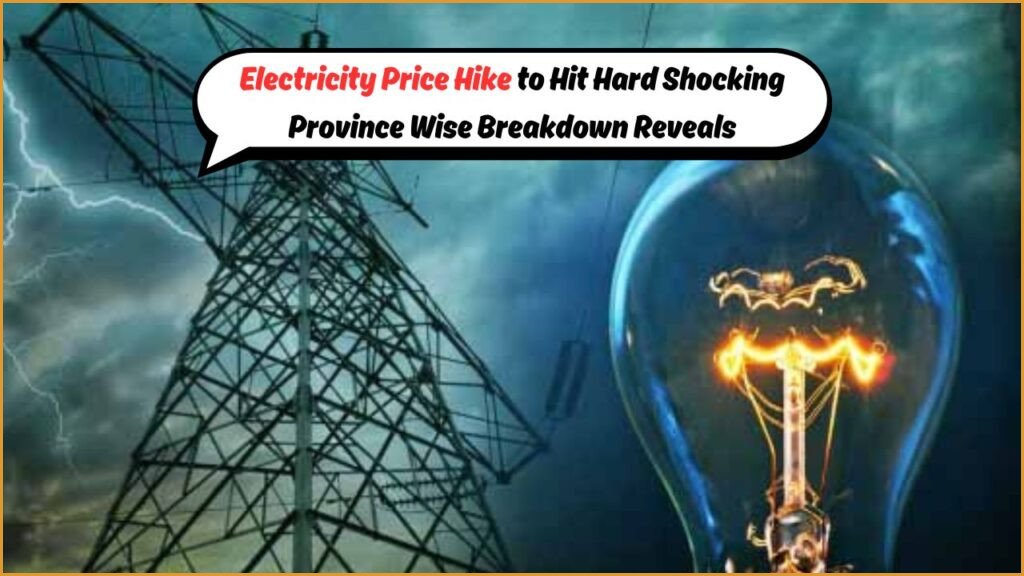Electricity Tariff Hike – In a move that has rattled households and businesses alike, the national electricity authority has announced a steep increase in electricity prices starting August 15. This price revision will impact every province differently, causing a wave of concern among the public. The new tariff structure, which is part of a broader economic reform plan, aims to recover operational costs, address circular debt, and improve the power sector’s financial health. However, for millions of consumers, it means higher monthly bills and tighter household budgets. The announcement follows months of negotiations with global lenders and energy sector stakeholders. Authorities argue that the step is crucial to reduce government subsidies and stabilize the national economy. Yet, public reaction has been swift and intense, particularly in provinces already struggling with inflation and stagnant wages. With this province-wise electricity rate hike, some areas are expected to see a spike of over 30% in their bills, especially for higher consumption brackets. The differential pricing will be based on factors such as regional demand, generation cost, and consumer type. Residential, commercial, and industrial users are all included in the revised tariff mechanism, although the increase will not be uniform across categories. This article provides a province-wise breakdown of the new electricity rates, highlights the most affected segments, and explores the rationale behind the hike. We also list departmental contact details for consumer complaints and support, along with a quick FAQ section for clarity.

Province-Wise Electricity Tariff Hike Overview
Each province will experience a different rate hike depending on their consumption, infrastructure, and local subsidies. Below is a summary of the revised unit costs and the extent of the increase.
Revised Unit Prices Per Province (Residential Consumers)
| Province | Previous Rate/Unit (PKR) | New Rate/Unit (PKR) | % Increase | Avg Monthly Bill (Before) | Avg Monthly Bill (Now) | Affected Population | Main Electricity Provider |
|---|---|---|---|---|---|---|---|
| Punjab | 18.5 | 24.3 | 31.35% | 3,700 | 4,900 | 27 million | LESCO, FESCO |
| Sindh | 19.2 | 25.1 | 30.73% | 3,900 | 5,100 | 19 million | K-Electric, HESCO |
| Khyber Pakhtunkhwa | 17.9 | 22.8 | 27.37% | 3,300 | 4,200 | 15 million | PESCO |
| Balochistan | 17.0 | 21.9 | 28.82% | 3,100 | 4,000 | 5 million | QESCO |
| Islamabad | 18.7 | 24.0 | 28.34% | 3,600 | 4,800 | 4 million | IESCO |
| Azad Kashmir | 16.5 | 20.7 | 25.45% | 3,000 | 3,800 | 2.5 million | AJKED |
| Gilgit Baltistan | 16.3 | 20.1 | 23.31% | 2,900 | 3,600 | 1.5 million | WAPDA/GB Energy Dept |
Key Segments to Face the Highest Burden
While all consumers will feel the impact, some segments are particularly vulnerable due to their electricity usage patterns or income levels.
Residential Consumers Using More Than 300 Units/Month
Heavy domestic users fall into a higher billing slab, thus facing steeper increases.
- Those consuming over 300 units per month will see hikes up to 35%
- Increased per-unit cost for higher slabs: PKR 32.1 from PKR 24.6
- Middle-income families will face monthly increases of PKR 1,500–2,500
Small and Medium Enterprises (SMEs)
These businesses form the backbone of the economy and operate on thin margins.
- Tariffs for commercial users increased by 20–28%
- Average monthly bill jump: PKR 6,000 to PKR 8,200
- May lead to higher prices of goods and services for end consumers
Government’s Rationale for the Electricity Price Hike
The increase has been justified by economic and operational challenges that the power sector currently faces.
Circular Debt and Subsidy Reduction
The government cites unsustainable subsidies and mounting debt as key drivers.
- Circular debt crossed PKR 2.6 trillion as of Q2 2025
- Government aims to reduce annual subsidies by PKR 450 billion
- IMF support program linked to energy sector reforms
Fuel Price Fluctuations and Dollar Index
The cost of generating electricity has surged due to fuel imports.
- Global LNG and oil prices rose by 18% YoY
- Rupee depreciation has further increased generation costs
- Imported fuel-based power now costs PKR 40–46/unit
Region-Specific Reactions and Protests
Different regions have responded differently based on their socio-political environment.
Punjab and Sindh: Political Pushback and Protests
These provinces witnessed widespread protests post-announcement.
- Lahore, Karachi, and Faisalabad saw street protests
- Trade unions and student groups also voiced opposition
- Political opposition parties called for rollback
Balochistan and KP: Public Concerns and Infrastructure Gaps
These regions are more affected due to lack of alternate energy sources.
- Poor grid infrastructure worsens the impact
- High losses in transmission mean lower quality at higher price
- Residents demand solar subsidies and targeted relief
Rural Communities: Marginalized and Ignored
Rural populations are among the hardest hit but receive the least attention.
- Many rely on agriculture, with little income flexibility
- Power outages and increased prices double their burden
- Demand for lifeline tariff slabs has grown
Industrial Sector: Passing the Burden to Consumers
Factories have few options but to transfer costs to consumers.
- Large-scale industry facing 20–25% increase in energy bills
- Costlier products and reduced profit margins expected
- Some units considering temporary shutdowns
Departmental Contact Details for Complaints & Assistance
If you believe your bill is incorrect or need support, contact the following departments based on your region.
| Province | Electricity Provider | Complaint Helpline | Email Contact | Website |
|---|---|---|---|---|
| Punjab | LESCO | 118 / 042-111-000-118 | complaint@lesco.gov.pk | www.lesco.gov.pk |
| Sindh | K-Electric | 118 / 021-99000 | kelectric@ke.com.pk | www.ke.com.pk |
| Khyber Pakhtunkhwa | PESCO | 111-000-128 | helpdesk@pesco.com.pk | www.pesco.com.pk |
| Balochistan | QESCO | 081-9201385 | customercare@qesco.com.pk | www.qesco.com.pk |
| Islamabad | IESCO | 051-9252937 | iescohelpline@iesco.com.pk | www.iesco.com.pk |
| Azad Kashmir | AJKED | 05822-921939 | ajked@pak.gov.pk | www.ajked.gov.pk |
| Gilgit Baltistan | GB Energy Dept | 05811-920165 | energy@gb.gov.pk | www.gb.gov.pk |
FAQs of Electricity Tariff Hike
1. When will the new electricity prices come into effect?
The revised electricity tariffs will be effective from August 15, 2025.
2. Will all provinces see the same price hike?
No, the increase varies by province depending on infrastructure and consumption patterns.
3. Are there any relief packages for low-income households?
Yes, lifeline consumers under 100 units/month will receive limited subsidy continuation.
4. How can I verify if my electricity bill is accurate?
You can call your electricity provider’s helpline or visit their website for bill verification.
5. Will industrial prices impact everyday goods?
Yes, increased industrial tariffs are likely to cause price hikes in consumer products.
Which province will experience the highest electricity price surge on August 15?
The province-wise breakdown reveals who will pay the most.
How do electricity prices vary across provinces after August 15?
The province-wise breakdown reveals varying costs for consumers.
How do electricity prices compare between provinces before the August 15 price increase?
Prices vary based on energy sources, consumption, and infrastructure.
What factors contribute to varying electricity prices among provinces post-August 15?
Demand, supply, regulations, and infrastructure influence electricity prices after August 15.
What are the anticipated impacts on consumer spending due to the electricity price shock?
Consumer spending may decrease in provinces with higher electricity costs.
How does the electricity price shock affect businesses in different provinces?
It impacts business operations and profitability differently across provinces.








